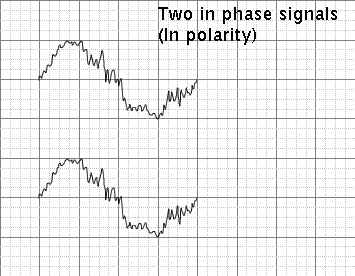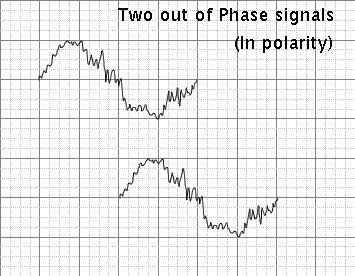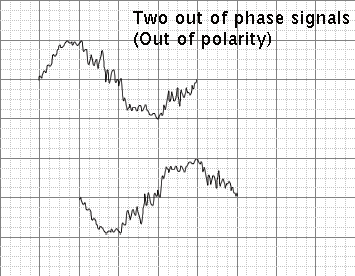Now, either read on, or watch our sister site's (projectstudiohandbook.com) video on phase and polarity here ..
In Phase - In Polarity
As we have seen, two identical signals or soundwaves can be in phase (thereby reinforcing each other), or out of phase (and cancelling each other) or somewhere in between, which will always affect the combined volume level in some way.
Imagine you have two speakers side by side, both playing exactly the same signal. Both speakers are wired up the same - positive to positive terminal, negative to negative terminal. The combined volume of both speakers will be practically twice the volume of just one speaker, because the soundwave will be in phase (phase reinforced).
In Phase, in polarity: These signals are identical and will phase reinforce.

Out of Phase - In Polarity
If you move one speaker, you will have shifted the phase of the soundwave, and as you move it further from the other speaker, the soundwave will shift more and more out of phase, affecting the combined soundwaves volume.
In a perfect theoretical world, the signal would be silent as the signals are out of phase (or phase cancelling). However, both speakers are in polarity, because they are wired up the same.
Out of phase, in polarity: Here the waveforms are in polarity, yet because the signal has been shifted in time or space, they are out of phase. Some cancellation of certain frequencies will occur (which will reduce the amplitude - however it will not cause total cancellation because the waveform is complex).

Out of phase - Out of Polarity
However, if you place both speakers side by side again, and wire one of them up incorrectly - connecting the positive wire to the negative terminal, and the negative wire to the positive terminal, you have inverted the polarity of the signal, which will affect the movement of the speaker cone.
Instead of moving outwards, it will move backwards - the opposite motion of the other speaker. This will be out of phase, or cancelled out (in a perfect, theoretical world). They are also out of polarity. If we move one speaker slightly, we are shifting the phase incrementally, but they remain out of polarity.
Out of phase, out of polarity: In this diagram, the phase has been altered slightly, but the waves are out of polarity.

In phase - Out of Polarity
Now move one speaker away from the other, as before. You will eventually shift the phase of the soundwave so that it is in phase with the other - however, it will still be out of polarity.
In doing so, the signals are in phase - that is, they have the same starting point and wavelength, and are now identical in time and space. However, the polarity is inverted, so they are out of polarity. The resulting wave (if we were using a sine wave, and in an ideal, theoretical world) would be phase reinforced.
In phase, out of polarity: because the waveform is complex, certain frequencies (eg: the fundamental frequency) will phase reinforce, but not all of them. You can see that the higher harmonics of the waveform are not identical.

The bottom line
By moving the speaker, you can shift the phase, but not alter the polarity.
You can only alter the polarity by swapping the wires!
Phase differences can be adjusted by small increments.
Polarity is either in, or out.
Footnote:
Question: Does the Phase button on a mixing desk shift the phase by 180 degrees (as it says in the manual), or does it simply invert the polarity?
Answer: I'm not sure whether this will confuse you, but the Phase button on a mixing desk inverts the polarity of a signal. Perhaps that's where the confusion arose in the first place!
